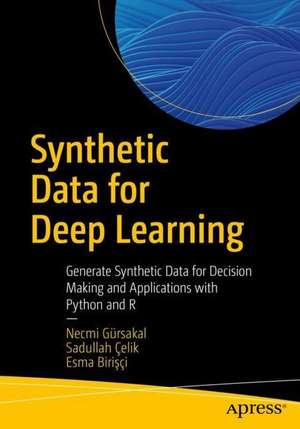Synthetic Data for Deep Learning: Generate Synthetic Data for Decision Making and Applications with Python and R
Autor Necmi Gürsakal, Sadullah Çelik, Esma Birişçien Limba Engleză Paperback – 2 ian 2023
Synthetic Data for Deep Learning begins by tracing the need for and development of synthetic data before delving into the role it plays in machine learning and computer vision. You’ll gain insight into how synthetic data can be used to study the benefits of autonomous driving systems and to make accurate predictions about real-world data. You’ll work through practical examples of synthetic data generation using Python and R, placing its purpose and methods in a real-world context. Generative Adversarial Networks (GANs) are also covered in detail, explaining how they work and their potential applications.
After completing this book, you’ll have the knowledge necessary to generate and use synthetic data to enhance your corporate, scientific, or governmental decision making.
What You Will Learn
- Create synthetic tabular data with R and Python
- Understand how synthetic data is important for artificial neural networks
- Master the benefits and challenges of synthetic data
- Understand concepts such as domain randomization and domain adaptation related to synthetic data generation
Who This Book Is For
Those who want to learn about synthetic data and its applications, especially professionals working in the field of machine learning and computer vision. This book will also be useful for graduate and doctoral students interested in this subject.
Preț: 332.71 lei
Preț vechi: 415.89 lei
-20% Nou
Puncte Express: 499
Preț estimativ în valută:
63.67€ • 66.07$ • 53.22£
63.67€ • 66.07$ • 53.22£
Carte tipărită la comandă
Livrare economică 17-31 martie
Preluare comenzi: 021 569.72.76
Specificații
ISBN-13: 9781484285862
ISBN-10: 1484285867
Pagini: 220
Ilustrații: XIX, 220 p. 86 illus., 74 illus. in color.
Dimensiuni: 178 x 254 mm
Greutate: 0.43 kg
Ediția:1st ed.
Editura: Apress
Colecția Apress
Locul publicării:Berkeley, CA, United States
ISBN-10: 1484285867
Pagini: 220
Ilustrații: XIX, 220 p. 86 illus., 74 illus. in color.
Dimensiuni: 178 x 254 mm
Greutate: 0.43 kg
Ediția:1st ed.
Editura: Apress
Colecția Apress
Locul publicării:Berkeley, CA, United States
Cuprins
Chapter I: Introduction to Data.- Chapter 2: Synthetic Data.- Chapter 3: Synthetic Data Generation with R.- Chapter 4: GANs.- Chapter 5: Synthetic Data Generation with Python.
Notă biografică
Necmi Gürsakal is a statistics professor at Mudanya University, where he transfers his experience and knowledge to his students. Before that, he worked as a faculty member at the Bursa Uludag University Econometrics Department for more than 40 years. Necmi has many published Turkish books and English and Turkish articles on data science, machine learning, artificial intelligence, social network analysis, and big data. In addition, he has served as a consultant to various business organizations.
Sadullah Çelik completed his undergraduate and graduate education in mathematics and his doctorate in statistics. He has written numerous Turkish and English articles on big data, data science, machine Learning, Generative Adversarial Networks (GANs), multivariate statistics, and network science. He has authored three books: Big Data, R Applied Linear Algebra for Machine Learning and Deep Learning, and Big Data and Marketing. Sadullah is currently working as Research Assistant at Aydın Adnan Menderes University, Nazilli Department of Economics and Administrative Sciences, and Department of International Trade and Finance.
Esma Birişçi is a programmer, statistician, and operations researcher with more than 15 years of experience in computer program development and five years in teaching students. She developed her programming ability while studying for her bachelor degree, and knowledge of machine learning during her master degree program. She completed her thesis about data augmentation and supervised learning. Esma transferred to Industrial Engineering and completed her doctorate program on dynamic and stochastic nonlinear programming. She studied large-scale optimization and life cycle assessment, and developed a large-scale food supply chain system application using Python. She is currently working at Bursa Uludag University, Turkey, where she transfers her knowledge to students. In this book, she is proud to be able to explain Python's powerful structure.
Textul de pe ultima copertă
Data is the indispensable fuel that drives the decision making of everything from governments, to major corporations, to sports teams. Its value is almost beyond measure. But what if that data is either unavailable or problematic to access? That’s where synthetic data comes in. This book will show you how to generate synthetic data and use it to maximum effect.Synthetic Data for Deep Learning begins by tracing the need for and development of synthetic data before delving into the role it plays in machine learning and computer vision. You’ll gain insight into how synthetic data can be used to study the benefits of autonomous driving systems and to make accurate predictions about real-world data. You’ll work through practical examples of synthetic data generation using Python and R, placing its purpose and methods in a real-world context. Generative Adversarial Networks (GANs) are also covered in detail, explaining how they work and their potential applications.
After completing this book, you’ll have the knowledge necessary to generate and use synthetic data to enhance your corporate, scientific, or governmental decision making.
After completing this book, you’ll have the knowledge necessary to generate and use synthetic data to enhance your corporate, scientific, or governmental decision making.
What You Will Learn
- Create synthetic tabular data with R and Python
- Understand how synthetic data is important for artificial neural networks
- Master the benefits and challenges of synthetic data
- Understand concepts such as domain randomization and domain adaptation related to synthetic data generation
Caracteristici
Explains how to debug and optimize advanced neural network architectures such as CNN and RNN Covers how synthetic data can be used to benefit autonomous driving systems Includes various types of GANs, how they work, and their applications
